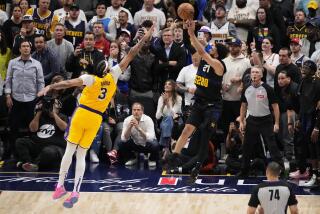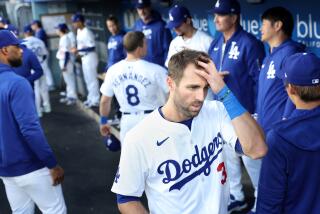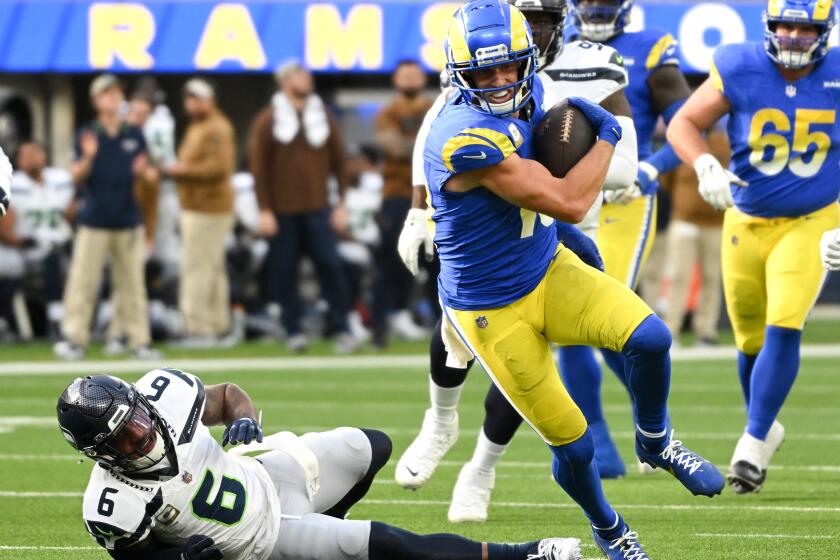The New Player in Pro Sports
Johnathan Wendel is in training. Eight hours a day, seven days a week, he sits in his basement, gunning down opponents in the video game Painkiller. About the only time he leaves his house is for a daily three-mile run. Then it’s back to the basement for round after bloody round of the first-person shooter, a game in which the player becomes the gunman.
Wendel, or Fatal1ty as he is known in the competitive gaming world, is a professional cybersportsman known for his skillful aim. At the Cyberathlete Professional League’s World Tour Grand Finals, kicking off in New York on Sunday, he hopes to take the $150,000 first prize, adding to the $86,000 he’s already earned competing in live tournaments this year.
That’s in addition to the tens of thousands he’s made licensing his name -- to computer motherboards, cooling systems, and sound and graphics cards.
For an increasing number of top-level players, video games are no longer just for fun -- they’re an “e-sport” that can make a career. Over the last few years, video gaming has grown into a highly competitive athletic phenomenon, with live tournaments, star players, devoted fans and, just as in the traditional sports world, big salaries and egos.
Many of today’s top cyberathletes are sponsored by corporations and earn six-figure incomes competing before live audiences in tournaments around the world. They are adored by fans who follow their every move on websites that detail gamer stats and stream games live, complete with commentary and analysis.
Although the mainstream media may not be familiar with the term “e-sports,” it’s poised to move from the hard-core gamer niche to the pop culture arena. On Sunday, MTV kicks off a week of video-game programming, which will include live coverage of the CPL finals. In early December, “60 Minutes” is expected to run a segment on e-sports. Madison Avenue is also taking notice.
*
Wendel stands in his kitchen, making turkey sandwiches on a small butcher block. A crusty, near-empty jar of Prego spaghetti sauce sits on a nearby table next to a wilting plant.
It’s 7 p.m., lunchtime for Wendel, who wakes up at noon, games for four hours, runs, eats, then games till 4 a.m. against half a dozen international players also training for the CPL finals.
“I’m so focused on this tournament, I don’t want to go outside much. I don’t want to party. I want to stay focused and be in my world,” said the 24-year-old Missourian, who speaks so quickly he frequently trips over his words.
It isn’t caffeine that makes him talk so fast. Wendel gave that up, along with alcohol, to make sure he’s “totally 100% ready to go and ready to win.”
Fit and blond, in a black T-shirt and basketball shorts, about the only thing that says “gamer” about Wendel is his intensity. His fresh-faced, apple-pie appearance is a far cry from the stereotype of a glassy-eyed, slack-jawed sloth who takes his fingers off the controls only to grab some chips.
Wendel is first and foremost an athlete. Before he became a professional gamer at 18, he competed in baseball, hockey, tennis, football, golf, billiards, even pingpong. The skill set for traditional and e-sports, he said, is the same: “Hand-eye coordination, reflexes, timing, strategy, dedication, being quick on your feet in the game, making very smart decisions in a split second.”
Video gamers get that. It’s nongamers who have a hard time envisioning what’s largely perceived to be passive entertainment as sport. But that’s beginning to shift now that video gaming, in all its permutations, has become such a cultural force.
MTV, the No. 1 cable network among 12- to 24-year-olds for the last eight months, will capitalize on its demographic overlap with the prime video-gaming crowd by launching its first “Game0RZ Week” on Sunday -- on air, online and with its on-demand broadband video service, Overdrive. Among the highlights of the week: All three days of the CPL tournament will run exclusively on Overdrive; on Wednesday, the winner will be a guest on “Total Request Live.”
“Video games really are a permanent part of their pop culture landscape of life, just like music, fashion and movies,” said Salli Frattini, MTV’s executive in charge of production.
With video game sales outpacing movie theater tickets and young male audiences turning off their TVs, many in the pro gaming world say it’s just a matter of time before mass-consumer products jump in.
“In 2006, what you’re going to see is the category going into mainstream lifestyle companies in a big way,” said David Grant, chief executive of the Global Gaming League, a company that’s been running online gaming tournaments since 2002 and sponsored its second live tournament this year. “We’re making a number of those deals right now.”
Once that happens, “the sky is the limit,” said Jason Bass, editor in chief of GotFrag. A competitive gaming website that emulates ESPN, GotFrag profiles top gamers, tracks gamer stats, and streams live, commentated games, among other things. “With blue-chip companies, the purse sizes will go up exponentially. In two years, I can easily see a million-dollar prize.... The World Series of Poker champion wins $7.5 million. That could easily be matched at some point.”
*
Wendel is chasing a bright red man through the halls and walkways of a sprawling, abandoned warehouse. His rifle sight is trained on his target; its chamber is loaded and ready to go.
“That’s right, run! Run like you always do!” said Wendel, who already had an 11-kill lead on the opponent visiting his basement -- “Beam,” a 17-year-old Finn ranked 22nd among Painkiller’s top pro players.
Wendel ranks significantly higher. Anyone in doubt can take a look at the oversized check running the width of his waterbed’s headboard. Anchored with two large trophies for other tournament wins, the $15,000 check is dated Oct. 16 of this year and made out to Fatal1ty, representing payment for his first-place finish at the CPL semifinals in Singapore.
Wendel adopted the name Fatal1ty when he was 15, taking it from the word that flashes across the screen when a player wins the fighting game Mortal Kombat. The “1” isn’t a vanity thing, he was quick to point out. It stands for the 1 in a T1 high-speed connection. When he was competing via dial-up, he was ranked 13th in the world in Quake 3; after he switched to T1, he rocketed to first.
Quake 3 is one of five first-person shooters in which Wendel has competed for cash. In each game, he’s been world champion at least once. He’s hoping for his 12th world championship with Painkiller.
Playing against Beam, Wendel either curses or clears his throat when he takes a hit. The dimly lighted basement bedroom where he plays is quiet except for the click of computer keys, as both players scoot their right hands around oversized Fatal1ty-brand mouse pads, using their left to work the keyboards. It’s only the game’s sound effects that are loud, and they’re trapped in headphones, which are clamped over the players’ ears so they can better hear what’s going on in the game and guide their actions.
If they were playing at a live tournament, they’d be doing the exact same thing, only they’d be wearing shoes.
They’d be competing before thousands of live, cheering fans who watch the matches on large video screens showing each player’s computer monitor and the expressions on their faces while listening to commentators giving the play-by-play.
“It’s a lot more pressure than sitting in your house in your underwear,” said Angel Munoz, who founded the Dallas-based Cyberathlete Professional League in 1997. “That was the first thing I changed when I started the sport. Everybody was playing on their own computers at home. I said, ‘That ends.’ We’re going to make all the computers the same. People must travel ... because you want the difference between two gamers to be limited to skill.”
At CPL tournaments, gamers are allowed to bring their own keyboard, mouse and headphones, but the more crucial game-play variables are nullified. All the computers are identical, with the same video cards, processors and monitors.
Competitive video gaming has its roots in the LAN parties that began in the mid-’90s. That’s when gamers started bringing their own computers to centralized locations, linking them to a common network so they could play each other live, without the lag of multiple servers and varying Internet connection speeds.
Official tournaments date to 1997, when Dallas-based video game developer Id Software ran a tournament for players of its popular game, Quake. The winner won a used Ferrari; everyone else got computer parts.
It was that tournament that gave Munoz, a former investment banker, the idea for the CPL. Realizing video gaming could be presented as a sport, “the spark went off,” he said. “The intensity is there. The desire for competition. People are practicing. The skill required is not something the average person can easily attain.”
The revenue model was also mapped out. Like other pro sports, he envisioned sponsorships, licensing deals, merchandise and ticket sales.
Eight years later, they are all a reality. And not just with the CPL. Today there are multiple leagues holding tournament series all over the world, the largest being the CPL, the E-Sports World Cup and the World Cyber Games, the latter of which took place last week, drawing 7,000 fans, players from 67 countries and 300 reporters.
New tournaments are springing up all the time. They are now a standard component of nearly every gaming convention, from long-standing gatherings like QuakeCon in Dallas to recent ones such as BlizzCon and IGNLive, both of which were launched in Anaheim this year.
Although some tournament series are for console games, like the recently launched Major League Gaming, most are for PC games due to the higher level of skill involved in playing with a keyboard and mouse. And although some tournaments are invitationals, most cull their top players through qualifiers and elimination rounds, both online and live.
By some industry estimates, there are 30,000 competitive gaming teams worldwide, and that’s in addition to players who compete one-on-one. Those numbers can only increase as more homes adopt broadband Internet service, growing the online gaming scene and upping the competition for its live tournament counterpart.
Wendel plans to take some of those gamers under his wing through a “giving back to gaming” program he started through his Fatal1ty brand company.
After his daily run, but before lunch, Wendel had an hourlong business call with Creative, one of three computer electronics manufacturers he’s working with to develop Fatal1ty products. Already, his name is stamped on three motherboards, two cooling systems, a graphics card and a sound card. Soon, he will add a mouse. Eventually, there will be a clothing line.
His first product, a Fatal1ty mouse pad, made him $50,000 almost overnight. He invested the money back into his company, using some of it to sponsor five other competitive gamers on the Fatal1ty brand team, Inevitable Fate.
Now there are 13 “Fatal1ty players.” Wendel hopes to sponsor hundreds more.
“The Fatal1ty brand, I want it to be a major part of the whole gaming scene and a big part of it becoming mainstream,” said Wendel. “I think we’ve been a big part of it so far, helping it grow. I think people know I mean it when I say I’m going to do this for the gamers, but we’re going to do it. The young kids love me, so it’s cool.”
More to Read
Get our high school sports newsletter
Prep Rally is devoted to the SoCal high school sports experience, bringing you scores, stories and a behind-the-scenes look at what makes prep sports so popular.
You may occasionally receive promotional content from the Los Angeles Times.






